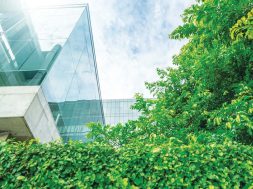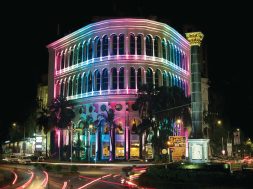16th May 2015. It all started 30 years ago, to the day. A small-built man started his ‘Make-in-India’ mission from a 10x10ft room armed with nothing but ` 10,000/- and inexhaustible determination. His mission, better known as H&K Rolling Mill Engineers Pvt. Ltd., (H&K India) was to soon become the trendsetter in India’s steel industry.
Raj Kumar Markan founded H&K India on 16th May 1985, in collaboration with Hoestemberghe & Kluetsch Gmbh, (H&K Germany), with the specific aim to introduce relevant and modern technologies to the Indian steel industry. Thus started a 30-year journey dotted with many firsts. India’s first ‘stop-start’ shear, first Crop Shear, and first Thermex quenching and self-tempering (QST) system were introduced by H&K India at Durgapur Steel Plant (DSP) of SAIL, when it won the global tender for Merchant Mill Modernisation of the plant in 1989. H&K India became the first amongst all DSP global contractors to commission the plant as per schedule in March 1992.
Mr Markan’s astute engineering and sheer grit so impressed SAIL that it also awarded to H&K India the tender for introducing the world’s leading QST technology, Thermex, for higher sizes of rebars at the Merchant Bar Mill of its Bhilai Steel Plant. H&K India did not disappoint; it commissioned the plant in 1994 much ahead of the scheduled completion date.
The company also boasted notable achievements in the secondary rolling mill industry and quickly found success in manufacturing special equipment for rolling mills. It introduced the unique grip and trough tilters at Kalyani Steels for rolling of alloy steel bars. “The trough tilter built by H&K India is only the third of its type in the world,” the company said.
H&K India’s single biggest ‘Make-in-India’ contribution has been the introduction of Thermex. At a time when the standard Indian practice was to use low-strength Cold Twisted Deformed (CTD) bars that were less ductile and very unsuitable to seismic India, H&K India revolutionised the steel industry by introducing the concept of QST. Thermex QST bars met all requirements of civil construction – yield strength ranging from 500 MPa or more, toughness, high elongation value and ductility – suitable for seismic India, weldability and excellent bend properties. The introduction of Thermex QST bars ended the 30-year reign of the less-ductile, low-strength CTD bars in India.
Recalling the three-decade run of his company, H&K India Chairman, Mr Markan, noted, “It all started at a chance meeting with Wolfgang KLUETSCH at Hotel Oberoi, Mumbai, in 1982. Mr KLUETSCH was then the Owner and Managing Director of H&K Germany. On his way to Australia he stopped over in India as he was studying the Indian market for H&K Germany’s specialised rolling mill machinery. We met many more times in Germany and subsequently in 1985 H&K India was born with Mr. KLUETSCH as its first Chairman.”Speaking from Germany, Mr KLUETSCH stated, “I am very proud that the seed planted by us in 1985 has today become a big tree which bears fruit. I extend my heartiest congratulations to the entire team of H&K India. Although I have retired some years ago, I do keep in touch with Mr Markan and his daughter, Radhika Markan, on a regular basis and they keep me informed about the company’s activities and growth. They make me proud by keeping the flag of H&K flying so high. I offer my best wishes to them for the years ahead.”
Inventor of Thermex and Technical Consultant to H&K India, Franz TAMM also sent his congratulations from Germany. “I am delighted to note the success H&K India and Thermex have had in the Indian market. In every country it is very difficult to overcome old traditions, or to change the established procedures and methods. When Thermex was introduced in India, it was so new, unique and revolutionary that it came to be resisted. But the H&K Indian team persisted and soon an awareness campaign was launched. India is exposed to earthquakes because 60 per cent of it falls under the high seismic hazard category. For high seismic zones, ductility of rebars was the key property and not the yield strength, and this was highlighted to the engineering fraternity. Today ductile Thermex rebars are popular in India. Such success is testimony of H&K India’s determination to its cause. I wish them many more successful years ahead.”
According to H&K India, “The world’s leading QST technology, Thermex, is in great demand in India. The beauty of Thermex is its simplicity. Each Thermex system is engineered to suit the rolling mill’s specific parameters. It takes just one billet/bar to commission the system and achieve the desired results and properties. The Thermex technology is very precise, besides being worker-friendly. The workers have no role to play other than to ensure the water is turned on.”
Mr Markan added, “This explains why H&K India has been able to successfully commission Thermex Technology in the Indian region with over 200 orders Thermex has proven its front runner status in the world for thermo-processed or QST technologies. Today approximately 60 per cent of rebars produced in India are Thermex rebars.”
“Our innovations in Thermex continue unabated. At SAIL which was our first order, we had introduced Thermex Version1. At present, we are manufacturing Thermex Version3. More significantly, we have successfully developed and commissioned the country’s first ‘Made in India’ 4-strand slit quenching pipe at Mahalaxmi TMT Pvt. Ltd. in Wardha, Maharashtra. We have the capability to manufacture and commission 2-slit, 3-slit and 4-slit Thermex quenching systems for varying sizes, speeds and temperatures.”
For 4-slit quenching at Mahalaxmi Wardha, the H&K India team led by Mr Markan undertook the entire engineering and manufacturing process in India, including equipment design, raw material procurement, machining, assembly, testing, and erection and commissioning in less than 4 months. It took less than 4 hours for successful commissioning of the Thermex 4-strand slit quenching equipment at Mahalaxmi Wardha.
“We have had a good 30-year run and we have been able to achieve this success because our partners stood by us. The Indian steel industry welcomed our new technologies and whole-heartedly backed us in our mission to raise Indian rebar standards to new heights. My company and I are thankful for their support and hope that they may continue to bless us for the future,” Mr Markan concludes.
——————————-Transforming India’s steel industry since 19851991: First ‘stop-start’ shear in India at DSP, SAIL 1991: First ‘stop-start’ crop shear in India at DSP, SAIL 1992: First grip tilters in India at Kalyani Steels 1992: First Thermex System at DSP, SAIL 1992: First bundling-binding systems (2 nos.) at DSP, SAIL 1993: First trough tilter at Kalyani Steels, Pune 1994: First Thermex System for 25-40 mm at Bhilai Steel Plant, SAIL 2000: First Thermex System for secondary sector mill 2009: 100 Thermex Systems Milestone reached 2014: First 4-strand slit Thermex Pipe commissioned.
24
Cookie Consent
We use cookies to personalize your experience. By continuing to visit this website you agree to our Terms & Conditions, Privacy Policy and Cookie Policy.









